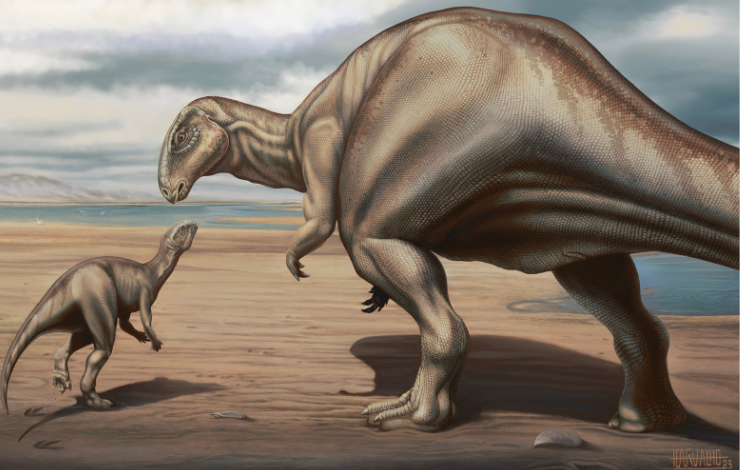02-04-2025

Image: Reconstruction, artwork by Vitor Carvalho
A team of researchers from the NOVA School of Science and Technology | NOVA FCT, in collaboration with the Universidad Nacional de Educación a Distancia (Spain), has announced the discovery of a previously unknown iguanodontian dinosaur species that lived in Portugal nearly 150 million years ago. This remarkable find represents a significant step forward in understanding the diversity of dinosaur fauna present during the Late Jurassic.
The study, recently published in the scientific journal Journal of Systematic Palaeontology, is based on specimen SHN.JJS.015, housed at the Sociedade de História Natural de Torres Vedras. The specimen has been identified as a herbivorous dinosaur belonging to the iguanodontian group. A detailed examination of the material confirmed that it does not match any previously identified species, which would increase the known diversity of dinosaurs in Europe.
“It was a surprise,” admitted Filippo Maria Rotatori, lead author of the study and researcher at GEOBIOTEC at NOVA FCT. “We believed that the diversity of this dinosaur group was already well-documented in the Late Jurassic of Portugal, but this discovery shows that there is still much to learn and that exciting findings may continue to emerge in the near future. Unfortunately, due to the limited material recovered, we are not yet able to assign a formal scientific name to this species.”
Beyond its uniqueness, this dinosaur also stands out for its size. “It was a heavyweight,” emphasized Fernando Escaso, another lead author and professor at UNED. “When we estimated its size and body mass, we found that this new dinosaur was significantly bulkier than other iguanodontian species, such as Draconyx or Eousdryosaurus, with which it most likely shared the ecosystem.”
“In addition to the main specimen, more fossil remains have been discovered at other sites in the region, including smaller isolated femurs, suggesting that these dinosaurs were relatively common in Portugal during the Late Jurassic,” explained Bruno Camilo, PhD student at Instituto Superior Técnico, University of Lisbon, and director of Ci2Paleo at the Sociedade de História Natural de Torres Vedras. "This is the first time that we have found different age groups of this type of dinosaur in Portugal, opening new research possibilities."
The discovery also reinforces Europe’s role in the evolutionary and migratory history of dinosaurs. “This animal shares many similarities with other iguanodontian species found in North America and other parts of Europe,” said Filippo Bertozzo from the Royal Belgian Institute of Natural Sciences. “During the Jurassic, the Iberian Peninsula likely played a crucial role in faunal exchanges between continents. We are still working to understand how these processes unfolded.”
"This research was made possible thanks to the collaboration of several European institutions and local organizations dedicated to preserving Portugal’s geological and paleontological heritage," added Miguel Moreno-Azanza from the University of Zaragoza.
In addition to researchers from NOVA FCT and Universidad Nacional de Educación a Distancia (Spain), key Portuguese research institutions participated in the study, including the Sociedade de História Natural de Torres Vedras and the Museu da Lourinhã, which house the studied material, as well as the University of Lisbon. The research team also included members from other international institutions, such as the University of Zaragoza (Spain) and the Royal Belgian Institute of Natural Sciences (Belgium).
This discovery confirms the Lusitanian Basin as a key area for paleontological research, continually providing valuable insights into the ancient ecosystems of the Iberian Peninsula. Ongoing excavations and projects lead researchers to anticipate further discoveries that will expand our understanding of the Jurassic past.
Read the full article here.